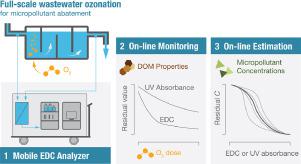Water Research ( IF 12.8 ) Pub Date : 2021-11-12 , DOI: 10.1016/j.watres.2021.117858 Nicolas Walpen 1 , Adriano Joss 1 , Urs von Gunten 2

|
Ozonation of secondary-treated wastewater for the abatement of micropollutants requires a reliable control of ozone doses. Changes in the UV absorbance of dissolved organic matter (DOM) during ozonation allow to estimate micropollutant abatement on-line and were therefore identified as feed-back control parameter. In this study, the suitability of the electron-donating capacity (EDC) as an additional surrogate parameter which is independent of optical DOM properties was evaluated during full-scale ozonation. For this purpose, a recently developed EDC analyzer was enhanced to enable continuous on-line EDC and UV absorbance measurements. During a multi-week monitoring campaign at the wastewater treatment plant of Zurich, Switzerland, specific ozone doses were varied from 0.13 to 0.91 mgO3⋅mgDOC−1 and selected micropollutants with different ozone reactivities were analyzed by LC-MS in conjunction with bromate analysis by IC-MS. In agreement with previous laboratory studies, the relative residual UV absorbance and EDC both decreased exponentially as a function of the specific ozone dose and, in comparison to the residual UV absorbance, residual EDC values showed a more pronounced decrease at low specific ozone doses ≤0.34 mgO3⋅mgDOC−1. Logistic regression models allowed to estimate relative residual micropollutant concentrations in the ozonation effluent using either the residual UV absorbance or EDC as explanatory variable. Averaging those models along the explanatory variables allowed to estimate target values in relative residual UV absorbances and EDC for specific micropollutant abatement targets. In addition, both parameters allowed to identify conditions with elevated conversions of bromide to bromate. Taken together, these findings show that the integration of relative residual EDC values as a second control parameter can improve existing absorbance-based ozonation control systems to meet micropollutant abatement targets, particularly for treatment systems where low ozone doses are applied.
中文翻译:

紫外吸收和给电子能力在二级处理废水全面臭氧化过程中作为微量污染物减排指标的应用
用于减少微污染物的二级处理废水的臭氧化需要可靠地控制臭氧剂量。臭氧化过程中溶解有机物 (DOM) 的紫外线吸光度的变化允许在线估计微量污染物的减排量,因此被确定为反馈控制参数。在这项研究中,在全面臭氧化过程中评估了供电子能力 (EDC) 作为独立于光学 DOM 特性的附加替代参数的适用性。为此,最近开发的 EDC 分析仪得到了增强,以实现连续的在线 EDC 和 UV 吸光度测量。在瑞士苏黎世污水处理厂进行的为期数周的监测活动中,特定臭氧剂量从 0.13 到 0.91 mg O3 ⋅mg DOC不等-1和选定的具有不同臭氧反应性的微污染物通过 LC-MS 结合 IC-MS 溴酸盐分析进行分析。与之前的实验室研究一致,相对残留紫外线吸光度和 EDC 均作为特定臭氧剂量的函数呈指数下降,并且与残留紫外线吸光度相比,残留 EDC 值在低特定臭氧剂量≤0.34 时显示出更明显的下降毫克O3 ⋅毫克DOC -1. Logistic 回归模型允许使用残留 UV 吸光度或 EDC 作为解释变量来估计臭氧化流出物中的相对残留微污染物浓度。沿着解释变量对这些模型进行平均,可以估计特定微污染物减排目标的相对残留紫外线吸光度和 EDC 的目标值。此外,这两个参数都允许识别溴化物向溴酸盐转化率升高的条件。综上所述,这些发现表明,将相对残留 EDC 值作为第二个控制参数的整合可以改进现有的基于吸光度的臭氧控制系统,以满足微污染物减排目标,特别是对于应用低臭氧剂量的处理系统。



























 京公网安备 11010802027423号
京公网安备 11010802027423号